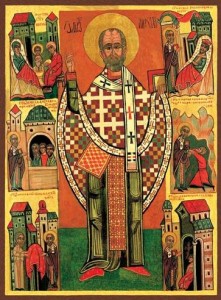I love Slava.
And I’m down with that.
I mentioned slava celebrations in my post about Christmastime. Slava days come throughout the year. For me, the holiday season kicks off with the first wintertime slava, St. Michael, November 21.
What is slava?
No, I don’t host slava. Traditionally, a family celebrates the father’s patron saint day, only in his house, until he passes away. At that point, the feast is taken over by the eldest son.
But all of that is changing now that adult children are moving away from their parents, sometimes so far that it’s impossible to celebrate slava in the same house. Also, as a way of honoring their fathers, I’ve seen adult daughters celebrate their family slava (scandal!).
In other words, I’m pretty much off-the-hook: My father-in-law is alive (and anyway, never celebrated his slava). I married a younger son. And oh yeah, I’m American; I cannot do not have it in me to prepare the multiple required dishes (cooked from scratch). Don’t even get me started on homemade cakes and cookies that are often cut according to rulered measurement, thereby ensuring true Type-A uniformity.
Serbia vs. US celebrations
I’ve been to slavas here in Belgrade and in America. The biggest differences, in my opinion: 1. The cigarette smoke factor in the former, and 2. The adhering to stricter religious and symbolic traditions in the latter.
Truly, hardly anyone smokes inside their house any more in the US. But once families move away from their hometown, many take to their old cultural traditions as a way of passing along their heritage to their kids. … And not losing it among the mixing pot that is the United States. Among other things, there may or may not be žito (a ground wheat and walnut combo), there may or may not be meat served.
For popular slava days, you may have more than one house to visit. It’s pretty much an open house, all-day event with a ton of food, set out and replenished throughout the day/night.
There are a few “rules” about slava, which may or may not be universal. As far as I’ve observed, once you’re invited to a slava, you are invited for life. So, you’ll get a “formal” call the first time, and that’s it. You’d better not forget next year.
Hence, the importance of having a current Eastern Orthodox calendar on hand. One of my Los Angeles girlfriends would always make sure to give me a copy, written in Latin not Cyrillic, so I could follow along.
Standard (traditional) gifts for party-goers is: a bouquet of flowers and a bottle of wine. At least, that’s what my husband insists on giving. If the family has young children, nice gifts for them is a good idea, but not required.
A note about flowers … There’s no tradition of “a dozen red roses,” or a dozen anything. Even numbers, as far as I can understand, is either a sign of bad luck, or used only for funeral arrangements. Three, or multiples of three, are best because they mimic the Holy Trinity. (Not to be confused with the Holy Threesome, as a Serbian girlfriend once mistakenly translated. Noooo not that kind of three.)
My daughter recently asked my husband if we could celebrate slava. “Only if you want to, tata.” So, maybe it is in our future …
* * * * *
* Of course there are female saints in Eastern Orthodox Church. It’s just I’ve never heard of, let alone attended, a slava for a female patron saint. Pre-Christian Serbian culture was polytheistic, with each family venerating its own (male) god-protector. Christian saints replaced Slavic deities.
Thanks to everyone who voted for me for the Expat Blog Award





Ah, slavas are such a complicated category to explain. They're truly unique and can be both fun and tiresome. Although we have slava in Macedonia, they're not so widely celebrated and to the extent like the Serbian slavas. My sister in Belgrade is on a slava every week. With that frequency, it can really get too much. By the way, I don't know if you've seen the movie 'Ivkova Slava', but it's a must. Really hilarious.

Sophie Novak recently posted..Liebster Blog Award
Sophie Novak recently posted..Liebster Blog Award
Sophie,
Okay, cool I will check out the movie, thanks! Yes, I think for me it's fun and interesting, but for those who live in a place where they have friends and family going back their whole lives, slava can become a litte overwhelming. My pleasure for the blog award
Laura
Oh, thanks for nominating me for the Liebster Blog Award once again.

Sophie Novak recently posted..Liebster Blog Award
Sophie Novak recently posted..Liebster Blog Award
I also love slava but these are really new things that I have been able to know about after a long time. It was really good to go through this type of post that has been a great thing to read.
This is a unimaginable site and I can not recommend you parents enough. https://bestbabyessentials.com“>car seats for negligible vehicles
March Madness 2019 Live http://themarchmadness2019.com/
I love this content keep sharing !!!
Fashion Fabrics provide a wide range of quality fabric. Lace fabric, Prints, laces, net embroidery, khadi, denim and more.
Buy Indian Fabric By The Yard, Indian Fabric Store Online
Fabric Store, fabric, laces fabric, faric lace, print fabric, printed fabric , laces in india, lace fabric in india, fabric store in india, online fabric in india, fashion fabrics online fabric, laces, Printed, Solids, Textured, Handloom, Cotton, Rayon, Crepe, Woolen, Velvet, Gold Block, Embroidery, rayon fabric, georgette fabric, polyester fabric, cotton fabric, fabric online, linen fabric, fabric design, silk fabric, lycra fabric, jacquard fabric, velvet fabric, ikat fabric, nylon fabric, knit fabric, knit fabric, chiffon fabric, woven fabric, upholstery fabric, online fabric store, textile shop near me, fabric stores, wool fabric, fabric material